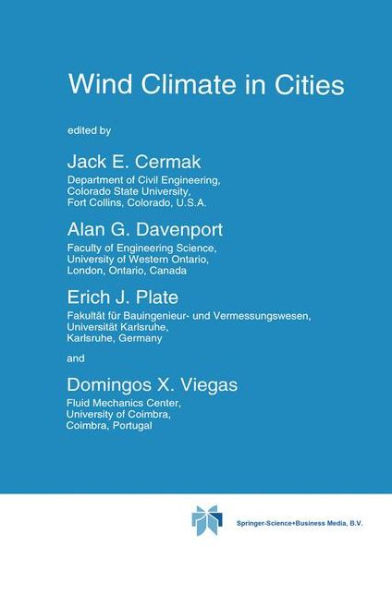5
1

Wind Climate in Cities
772
Wind Climate in Cities
772Paperback(Softcover reprint of hardcover 1st ed. 1995)
$549.99
-
PICK UP IN STORECheck Availability at Nearby Stores
Available within 2 business hours
Related collections and offers
549.99
In Stock
Overview
If one surveys the development of wind engineering, one comes to the conclusion that the challenge of urban climatology is one of the most important remaining tasks for the wind engineers. But what distinguishes wind engineering in urban areas from conventional wind engineering? Principally, the fact that the effects studied are usually unique to a particular situation, requiring consideration of the surroundings of the buildings. In the past, modelling criteria have been developed that make it possible to solve environmental problems with great confidence, and studies validated the models: at least in a neutrally stratified atmosphere. The approach adopted in the book is that of applied fluid mechanics, since this forms the basis for the evaluation of the urban wind field. Variables for air quality or loads are problem specific, or even random, and methods for studying them are based on risk analysis, which is also presented. Criteria are developed for a systematic approach to urban wind engineering problems, including parameter studies. The five sections of the book are: Fundamentals of urban boundary layer and dispersion; Forces on complex structures in built-up areas; Air pollution in cities; Numerical solution techniques; and Posters. A subject index is included.

Product Details
| ISBN-13: | 9789048144853 |
|---|---|
| Publisher: | Springer Netherlands |
| Publication date: | 12/08/2010 |
| Series: | NATO Science Series E: , #277 |
| Edition description: | Softcover reprint of hardcover 1st ed. 1995 |
| Pages: | 772 |
| Product dimensions: | 6.10(w) x 9.25(h) x 0.06(d) |
Table of Contents
The Risk of Wind Effects in Cities.- Urban Climates and Urban Climate Modelling: An Introduction.- Atmospheric Boundary Layer and its Parameterization.- Scaling for Convective Boundary Layers.- The Heat Island of the Urban Boundary Layer: Characteristics, Causes and Effects.- Atmospheric Flow through Groups of Buildings and Dispersion from Localised Sources.- Physical Modelling of Atmospheric Dispersion in Complex Settings.- Analysis of Meteorological Data and Main Problems Related to the Determination of Building Exposure.- Local Wind Pressures for Rectangular Buildings in Turbulent Boundary Layers.- The Response of Slender Structures to Wind.- Wind Loads on Structures from EUROCODE 1, ENV 1991-2-3.- Interference Effects on Flexible Buildings and Structures.- Wind-induced Response of Buildings Arranged in a Group.- The Influence of Surroundings on Pressure Distributions around Buildings.- Wind in Cities: Effects on Pedestrians and the Dispersion of Ground Level Pollutants.- Damage to Buildings by Storms in Urban Areas.- Urban Climates and Air Pollution in Small Swiss Cities.- Physical Modelling of Flow and Dispersion over Urban Areas.- A Laboratory Simulation of Urban Heat — Island — Induced Circulation in a Stratified Environment.- Wind Tunnel Modelling of Convective Boundary Layers.- Concentration Fluctuations in Plumes: Observations and Models.- Point Sources in Urban Areas: Modelling of Neutral Gas Clouds with Semi-empirical Models.- Convective Heat Losses from Buildings.- Traffic Induced Pollution: Diffusion in the Neighbourhood of Tunnels and Streets.- Traffic Induced Pollution: How to Evaluate Wind Tunnel Data for Municipal Decision Makers.- Modelling of Motor Vehicle Immissions in a Street System by Combination of Lagrange Models and Surface Wind FieldSimulation in Complex City Structures.- Accidental Releases of Heavy Gases in Urban Areas.- Dense Gas Dispersion in Complex Settings: Part 1 — The Effect of Obstacles.- Dense Gas Dispersion in Complex Settings: Part 2 — The Effect of Topography.- to the Numerical Simulation Approaches in Wind Engineering.- Simulation of Flow past Buildings with Statistical Turbulence Models.- Large-Eddy-Simulation of the Three-dimensional Flow around Buildings.- Numerical Simulation of Turbulent Diffusion in Cities.- Application of the RAMS Numerical Model to Dispersion over Urban Areas.- Simulating the Effects of Stable Stratification on Flow and Dispersion around a Cubical Building.- Numerical Simulation of Steep Terrain Influences on Flow Patterns at the Isle of Helgoland.- Reduction of Horizontal Wind Speed in a Boundary Layer with Obstacles.- Dependence of Scaling for a Convective Atmospheric Surface Layer on Size of Turbulent Disturbances.- Wind Research Climate at Texas Tech University — An Overview.- Automatic Linking of Three-dimensional Models with Different Grid Granularity.- An IBL Experiment over Athens Urban Area.- Wind Resistance Categorization of Buildings.- Numerical Experiments on Urban Heat-Island Intensity.- PBL Observations and Measurements in the Area of Rome.- List of Contributors.From the B&N Reads Blog
Page 1 of
